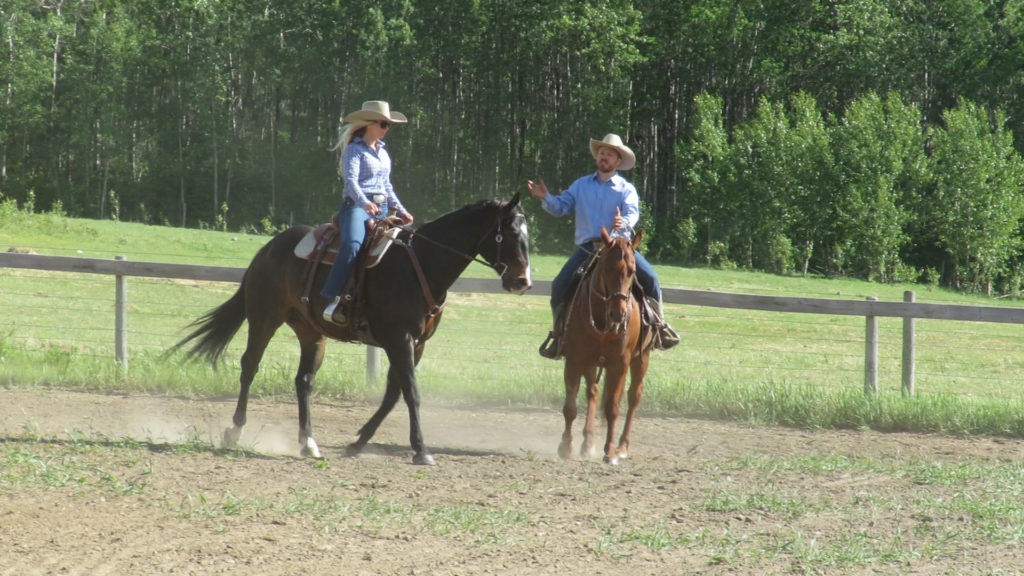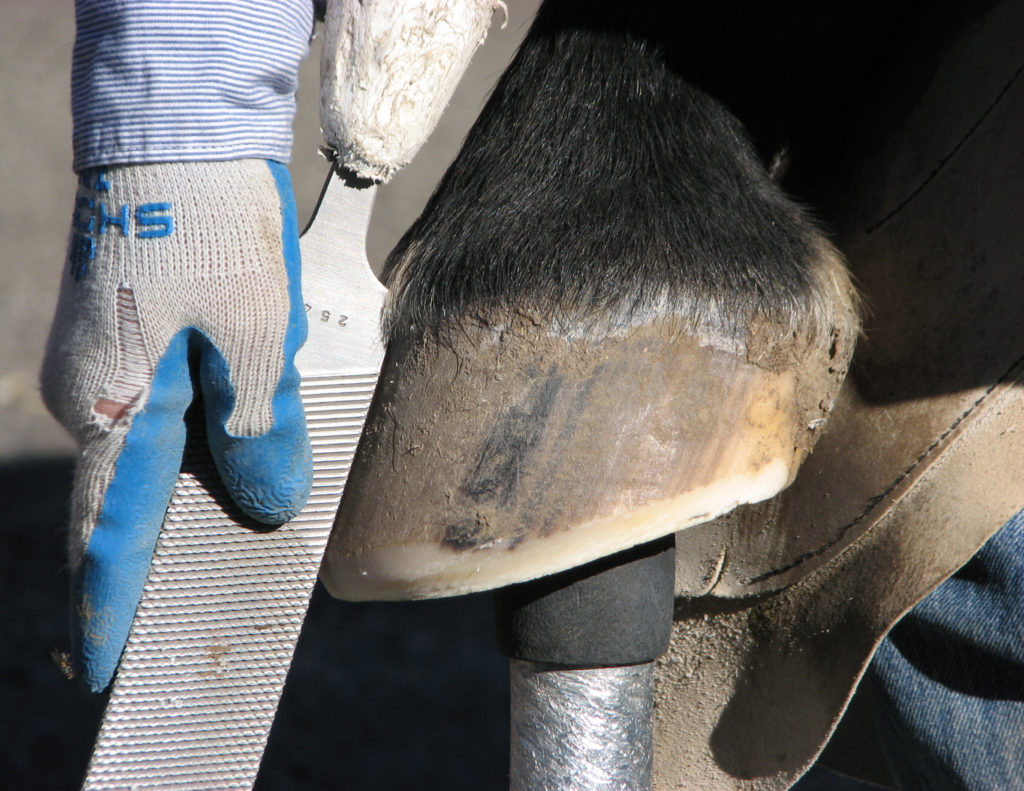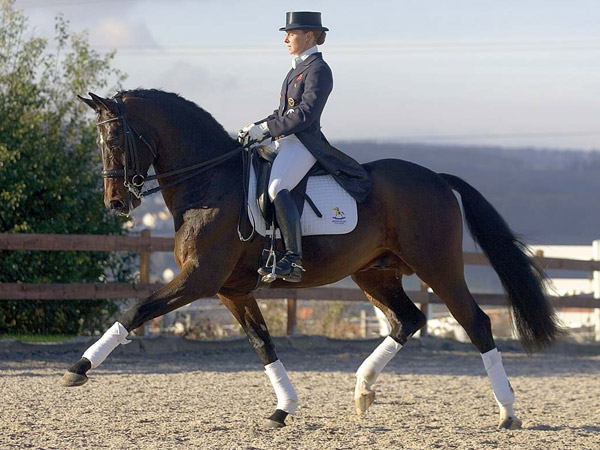
Whether I’m teaching a student or working cattle, I rely on my horses’ healthy bare feet to help me get the job done.
I do a lot of different activities with my horses, from arena training to trail riding to long days working cattle. My ability to do my job relies heavily on my horses, so I need to keep them as healthy and sound as possible, whatever we are doing. When it comes to hoof care, I have found that my horses are most likely to remain strong and able to work when they are maintained with physiologically correct barefoot trimming. This is not the same thing as what many people call a “pasture trim”. It requires specialized knowledge of how the equine hoof is meant to function, how to optimize hoof shape and balance to maximize function, and what to leave alone so that you don’t inadvertently keep a horse foot sore by “cleaning it up” too much with the hoof knife at every trim.

Physiologically correct trimming promotes healthy, straight walls, thick soles, strong heels and robust frogs, all of which combine to create greater soundness. (Photo courtesy of The Essential Hoof Book)
By maintaining my horses in this way, I find I have far fewer hoof problems and lameness issues than I see in comparable shod horses. I also greatly prefer the feel of riding a barefoot horse, as there is a real difference in how barefoot horses sense and respond to the ground. I believe this is because healthy bare feet have the greatest proprioception, which can be defined as “the sensing of the environment, and the sense of the position of parts of the body, relative to other neighboring parts of the body.” The work of the great Dr. Robert Bowker showed us that the frog, in particular, is filled with tiny sensors (called proprioceptors) that allow the horse to respond immediately to changes in footing, slope, etc. A healthy bare foot has the back of the frog making contact with the ground, thus maximizing proprioception and allowing the horse to use his own body in the best way to balance himself and avoid injury. Some people believe that a horse will slip more in rough country or when working at speed without shoes, but I find just the opposite to be true. My barefoot horses have terrific grip, and their sure-footedness enables me to trust them over any type of terrain.
I also find that barefoot horses move better overall, as they seem to be more connected to their entire body. Some people say this is because shoes actually restrict blood flow in the foot to some degree (an idea that Dr. Bowker’s work supports), creating a feeling of numbness in the foot. If you’ve ever had a foot fall asleep, you will recognize that feeling disconnected from your feet would not put you at your best for athletic endeavors! There is definitely a liveliness in the step of a barefoot horse that I really enjoy, and I agree with barefoot enthusiast and British Olympian Emma Hindle, who says that barefoot horses move more correctly. Other benefits include zero down time from lost shoes, quicker heart rate recovery after exertion, and, as a family man with three young children, I definitely appreciate the financial benefit of keeping my horses barefoot, as trimming costs far less than shoeing.

British Olympian Emma Hindle is a big believer in the many benefits of barefoot hoof care, not the least of which is more correct movement in the horse.
All that said, barefoot can present some challenges. In particular, when the ground is really soft and wet and the feet are not hard, walking on rocks can be a challenge for the horse. I’m also respectful of my horses’ feet when riding on hard-packed roads topped with big chunky gravel, as that is not comfortable for most barefoot horses.
Still, I find that the benefits of barefoot hoof care far outweigh the occasional inconveniences, especially as I know that my horses are likely to stay sounder, and for longer, without metal shoes. In general, I have not put shoes on any of my horses unless I needed them to slide, in which case I used slide plates on the hinds. Barefoot horses simply don’t slide well, as their feet have too much grip. Other than that, they seem to work and feel better barefoot, and that works just fine for me.

Hi Josh, a good little read. Leroy has been barefoot and predominately sound since November. His back is improving and we are navigating what helps and what does not. His hooves look incredibly healthier and I believe that he continues to experiment with proprioception. I have just ordered some Sure Foot Pads to deepen his experimentation. Thanks for your thoughts around this back in October 2019
Hi Josh ! I agree with you my horses remain barefoot. I have the My Farrier come every 4to six weeks, just to keep the feet strong and not to long as I also have Old MAC boots that I use it on rocky terrain.
Hi Josh,
I am a lurker, but this topic requires me to respond. I have worked with horses my whole life, from field to upper level 3day eventing. For the past 10 yr my horses have been barefoot, which I support with studded cavallo boots if necessary (icy roads). As you say I find their barefoot traction quite remarkable and 95% of the time I have no reservations. However, I also ‘fox’ hunt in the fall and have always worried about barefoot traction when the footing is rainy/wet – specifically galloping around corners. Question # 1: am I expecting too much of the barefoot horse to ask them to have 100% traction in conditions that they probably would never expose themselves to if in the wild?
Question #2: Have you ever asked yourself of the incongruity of putting sliders on your reining horse so they can slide par excellence, yet the whole point of a sliding stop is theoretically to upend the steer which is at the end of your rope … ?
Love your views and discussions, and will likely join your level 1 group, but until then I will retain my lurker status,
Christie Riddell
Center Rawdon, NS
Great thoughts and good questions! I do believe there is a time and place for all things. I agree with your struggle here. When a horse’s feet are conditioned to soft ground the foot gets very soft. This demands that we make a change to balance things out. This change could be shoes, boots, etc, some way to keep them from excessive soreness. If the job demands a change we need to sort out what it needs to be to preserve the horse. Most of the time barefoot works other times we need to adapt. This leads me to question #2. I don’t compete at this time but I have enjoyed the process of training a horse to sit deep and use their sliders to float through the ground, which is hard on the legs of a barefoot horse. I guess what I’m saying is that there are some situations that shoes do a great job! Very excited to have you in the space and appreciate your questions!
I have known people who put boots on their horses for the one or two days they have the horses in the mountains. I suppose the horse has about as much feel of the ground as we would have doing fine work with gloves. However the boots are better than sore, cut or bruised feet and we do use oven gloves which at times are awkward things but better than burned hands! As you have pointed out, there is a place and time for everything.
Great article. I tried letting my gelding go for years barefoot. I know they are better at feeling the terrain than they are with shoes or boots. However, after years my horse turned up lame and now requires shoes on a regular basis. He was pretty sore most of the time to the point that when you’d ask him to move out, he’d resist. He’s great now with shoes. My mare on the other hand has never needed shoes. She has feet as tough as nails. I don’t think all horses have good enough feet to be barefoot all the time. But this was a great article. Thanks Josh.
I totally agree that certain situations call for different actions, in the end we are always trying to figure out what is best for the horse to live healthy, happy and functional!